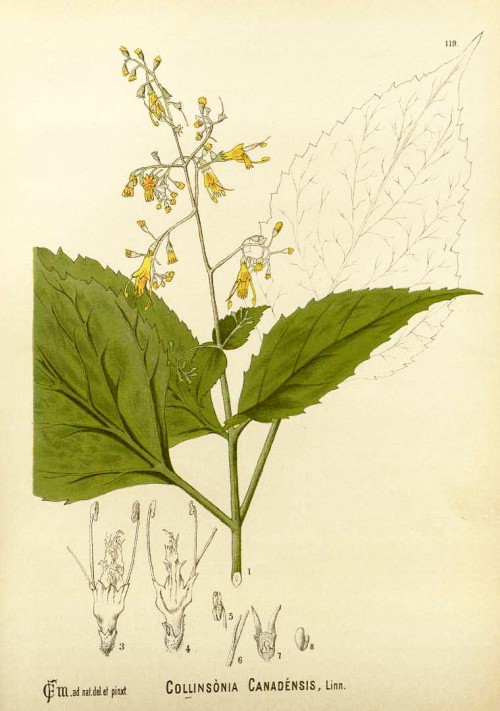Collinsonia canadensis L. - Lamiaceae - northern horsebalm, Canada horsebalm, stoneroot
Perennial herb, up to 0.80m high, native to the eastern North America; leaves simple, opposite; flowers yellow, lower lip fringed.
„Collinsonia. This Plant grows five Feet high; hath, in the Fall, after Harvest, a Smell something like Hops; the Seed is much like Sage Seed. This, in some Parts of the Country, is called Horse Weed, not only because Horses are very greedy of it, but it also is good for sore gall'd Backs. The Root is hard and knobby, and is much commended for Womens After-pains, being pounded, boiled and the Decoction drank.“
[Hobbs, C. (1991). The Medical Botany of John Bartram. Pharmacy in history, 181-189]
„Collinsonia is of great value in the hemorrhoids of the pregnant female, with imperfect venous circulation in the pelvic viscera… My suggestions concerning its positive action in hemorrhoids alone, or combined with
hamamelis, as may be indicated, have been acted upon by very many physicians who have reported brilliant results, and an increasing confidence in the remedy.“
[American Materia Medica, Therapeutics and Pharmacognosy. Finley Ellingwood, M.D., 1919]
http://www.swsbm.com/Ellingwoods/Ellingwoods_plants_only.pdf
„ It does have a distinct odor, described by herbalist David Winston as smelling like Lemon Pledge…
It was not until later after observing Native American medicinal uses of the plant that the herb came into the materia medica. By the 1850s it was listed in King's American Dispensatory and in Lee's New York Plants. Lee noted that the bruised leaves had been used for many years as poultices for bruises and that the Thompsonian medicalists had referred to it in their pamphlets. One factor in the long adoption was that the elements of the plant only appeared with long extraction. Another was that the root was hard and knotty: the Lloyd Brothers pamphlet on the plant notes that it tended to break grinding machines and was difficult to extract…“
http://en.wikipedia.org/wiki/Collinsonia_canadensis
The steroidsaponins akeboside STb, collinsonin and collinsonidin were isolated from the roots of Collinsonia canadensis.
[Saponins from Collinsonia canadensis. Joshi, B. S., Moore, K. M., Pelletier, S. W., Puar, M. S., Pramanik, B. N., Journal of Natural Products, Vol.55(10), 1992, 1468-1476]

Millspaugh, C.F., American medicinal plants, vol. 2: t. 119 (1892)
http://www.plantillustrations.org/species.php?id_species=264327